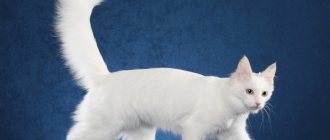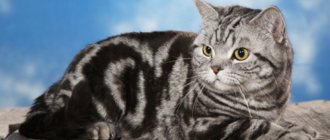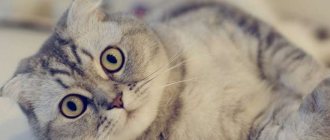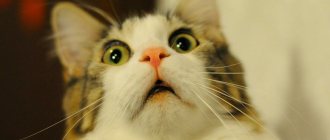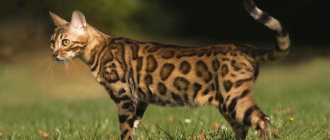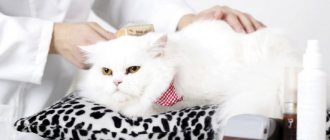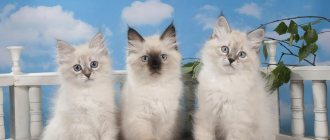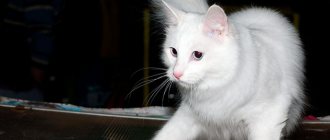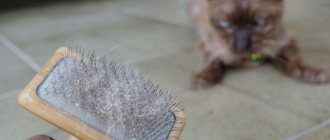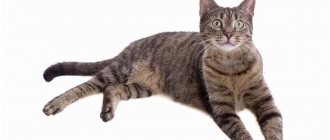Characteristics of an Oriental cat - character and habits
By their nature, Orientals are real stars because they want to be the center of attention. They will not wait peacefully while the owner goes about his business. Instead, the ori will readily jump onto his lap or spin around, demanding immediate attention.
At the same time, they are also extremely sociable - the breed is capable of making a variety of sounds from purring to meowing with different tonality and duration. Therefore, in the absence of proper attention, the furry pet is ready to drive the owner crazy with its demanding talkativeness.
Character
Kittens of this breed easily get used to new surroundings, run around actively, and explore every corner. But as the animal grows up, it acquires oriental imposingness and contemplation: let the children frolic in the house, the husband and wife start renovations and noisily move the furniture - the pet will sit on a soft sofa and watch the incomprehensible fuss with Asian calm.
Don’t try to take this cat out for a walk – the furry homebody doesn’t like to leave his familiar premises. And he does the right thing - his fur coat is light, not intended for frosts and cold winds.
The passivity of an animal does not mean that it does not need the company of people. Oriental longhaired cats do not tolerate loneliness at all. They will not take part in noisy fun, but will watch the wild fun from the sidelines with interest.
The favorite pastime of long-haired Orientals is to purr around their owner. They perceive the lack of attention from loved ones very painfully. A cat will like a house full of guests much more than being alone.
You can get a dog or other pet - this cat will get along with everyone with oriental patience, and jealousy is not characteristic of him. Only when the owner is not around, no four-legged friend can replace him.
An Oriental longhaired cat is not suitable for people who are away from home for a long time. It is not advisable to get her if you are constantly busy and cannot find time for intimate communication with your pet. But for families where there is a person with a mental illness (without attacks of aggression) or autism, this breed will be an excellent helper (if it is difficult for the patient to talk with representatives of his kind, then communication with animals occurs on a more subtle level). The eastern four-legged “sage” will find a common language with anyone - and “conversations” with him can last for hours.
Description of the breed
Like any representative of the species, an Oriental cat must meet a certain breed standard. Compliance with regulations is especially important for owners planning exhibitions and breeding of animals. But even someone who takes an Oriental just as a companion needs to understand what a pet should look like.
Appearance - what an oriental looks like
The head is of medium size and clearly proportional to the body. The shape resembles a wedge with straight lines. The wedge starts from the nose and gradually widens towards the ears. When viewed in profile, a slight convexity of the skull is determined. The forehead is flat. The ears are large, set wide and directed straight, at an angle in relation to the head. They are wide at the base, but the tips become pointed. The eyes are medium in size, almond-shaped and slightly slanted towards the nose. The classic shade is bright green. The nose is long and straight.
The neck is long, with a smooth transition into the line of the back. The body is long, with clearly defined muscles, but graceful. The limbs are slender and proportional to the body. The paws are oval shaped and quite small. The tail is thin and long, tapering towards the tip, reminiscent of a whip.
Today, according to their appearance, Orientals are divided into two types: classic and extreme. Extreme type cats have low-set ears and a very elongated muzzle.
Size
Normal height at the withers for an adult Oriental is considered to be between 23 and 25 cm. The body can be up to 90 cm long.
Weight
The average weight of an adult cat of the Oriental breed ranges from 3.7 to 4.5 kg. The normal weight for a cat ranges from 2.3 to 3.2 cm.
Wool
The breed is short-haired, the hair is fine and shiny. All fur should lie close to the body and be silky to the touch. There is practically no undercoat.
Colors
The classic colors of Oriental cats are:
- Ebony is a black shade of wool, also called black solid.
- Bronze - the shade resembles bronze, but a bright red color is acceptable, closer to red, while the paw pads and nose are soft pink.
- Lavender - this color is also positioned as lilac, the paws and nose are lavender, sometimes their shade is closer to pink.
- Havana is a classic chocolate color, can vary from light to dark brown, paws are brown-pink, nose is brown.
- Blue - a combination of gray-blue with a slight shade of silver, paw pads and nose are blue.
- Cream or fawn - includes fawn (beige coat) and cinnamon (shades of red or very light brown), paws and nose should be pink.
- Tortoiseshell or tri-color - it combines white, black and red wool.
- White is a unique color without a yellow tint, the paws and nose are soft pink, the eyes can be not only green, but also blue, or heterochromia may appear.
In addition, Ories can have a tabby color (the presence of spots, flats, marbled patterns, etc.) on top of the main shade of the coat.
Care
Wool
Oriental wool is very easy to care for. Their short and smooth coat does not require daily brushing. It is shiny, fits tightly to the body and does not shed as often as other cats. Orientals have no undercoat.
The Oriental's fine fur does not pick up much dirt and debris, so there is no need to bathe it often, otherwise you can damage the coat by removing the protective sebum on its skin.
It is better to clean the fur with soft silicone brushes; this should be done no more than once every 4 weeks. The animal's ears and eyes require care, mainly wiping with lotion and periodic examination for abnormalities in ear and eye discharge.
Nutrition
Orientals are not prone to overeating, so you can leave dry food available to your pet at all times. At first, kittens eat often, later they choose their own diet. You can see our rating of dry food for adult cats here.
It will be enough on your part to keep the food and water bowls full at all times.
Important! Some nurseries practice mixed nutrition. If your kitten is from such a nursery, then it may need to be additionally fed with meat or dairy products. Be sure to consult your breeder when choosing food for a kitten.
Walking your pet
Orientals are well kept in apartments. They do not suffer from lack of walking on the street or in the garden. Walking your pet is possible on a leash.
If your cat does not wear down its claws on walks, then you definitely need to install a scratching post in your apartment and train it to use it. Like any other useful habit, it is better to start learning from an early age.
Are Oriental cats hypoallergenic or not? How often do they shed?
Orientals can be called practically hypoallergenic, since their protein (which provokes allergies in humans) is synthesized to a lesser extent than in other breeds.
Shedding in eastern cats is moderate, and therefore does not cause any special problems. With proper care of the coat and sufficiently humidified air in the house, shedding will occur only in the autumn and spring seasons. At this time, the owner will need to increase the frequency of brushing the pet to several times a week.
Breed card
| Characteristics of a cat | Notes | |
| General information | Oriental cats come from the Siamese line. It was from the Siamese that a strong character, playfulness and piercing eyes were passed on, although not necessarily blue. | Monochromatic cats are more popular |
| Character | Very affectionate, talkative and active cats. They require a lot of attention and will seek it using any available method. | |
| Appearance | Smooth-haired, elegant cats with a thin, elongated body and a triangular head. Lots of colors, some potential combinations haven't even appeared yet | |
| Behavior at home | They miss their beloved owner, so if you are away from home for a long time, get two Orientals. Being in a pair, cats will not be so bored and will not destroy the apartment in search of entertainment. They like to tap their paws on the floor to attract attention. | A very talkative breed. The voice of Orientals is loud and similar to the cry of a child, and sometimes even to a car horn. |
| Care | Short hair requires minimal grooming. It is enough to comb 1-2 times a week | Oris love the ritual of combing very much, because this is additional attention from the owner |
| Health problems | Sometimes hereditary heart disease | |
Playfulness
An eared cat with a Georgian nose will happily run after a ball, bring toys to its owner like a dog, and simply play with a new thing. She is active and mobile, loves to explore everything, and there is not a place in the house where she will not climb, informing the owner about it. Sometimes she can purposefully hide and watch as people are looking for her, and then suddenly jump out, inviting her to play. It will be useful for the future owner of an ori to purchase a gaming complex for the pet in order to engage the pet in an activity without your participation.
Genus oriental cats + bonus - manul.
Genus oriental cats + bonus - manul.
I continue with cat posts. Today we are visiting or visiting us, I don’t know how to spell it correctly, oriental cats and manul cats. Let's take a closer look at the representatives of the small cat family - the genus of oriental cats. This is a Bengal cat
Sumatran cat.
Spotted-red (rusty) cat.
Fishing cat (viverrid cat).
And then we will get acquainted with the Pallas's cat, another representative of the family of small cats, the Pallas's cat, the genus of which he is the only representative.
Go. Oriental cats. Let's start with the Bengal cat.
Bengal cat. - a cute animal, the size of a domestic cat. Body length up to a meter with tail, height at the withers up to 40 cm, weight from 4 to 7 kg.
The Bengal cat has a huge habitat. From the Amur region, through Korea. China to India, Pakistan and Indonesia. On islands. Tsushima, Taiwan, Hainan, Jeju, Java, Sumatra, Kalimantan, Bali, Lombok and some islands of the Philippines. Bengal cats can live in completely different biotopes: tropical forests, coniferous forests, in the mountains at an altitude of up to 3000 thousand meters on rocky areas, in the savannah. Only deserts are avoided. They prefer to live near the water, away from people.
With such a huge habitat, the Bengal cat has 11 subspecies, which often differ in name and have significant external differences. For example, the Far Eastern forest cat is a subspecies of the Bengal cat. Please note that the cats look a little different.
Bengal cats are solitary hunters, their peak activity is twilight and night. Typically, these cats occupy a territory of up to 10 kilometers, mark it and drive out rivals. During the day they rest in shelters located in the roots or hollows of trees, caves and burrows abandoned by other animals. They swim well and climb trees. Sometimes they hunt by jumping on top of the prey. The diet is based on rodents, but they also hunt other animals, squirrels, hares, birds, reptiles and amphibians. Bird eggs are found and eaten. They can fish, but they rarely do so.
To raise offspring, Bengal cats unite in pairs. Usually 2-3 kittens are born. They live with their parents for up to 10 months.
Natural enemies of Bengal cats are other predators, including birds. But this did not stop the species from thriving. Bengal cats were once one of the most common cat species. Until people began to exterminate them en masse for their skins. Today, the hunt for these cats continues in China. The species is generally not endangered. But certain subspecies, for example, the Far Eastern forest cat, are listed in the Red Book.
The Bengal cat is wild and very difficult to tame. She will not become a member of the family. To keep in captivity you will need an aviary.
There is a breed of domestic cat called the Bengal. Wild Bengal cats began to be crossed with domestic cats. The percentage of wild genes in them varies. They become very attached to their owner. They cannot stand loneliness and can destroy the house out of sadness; they are difficult pets.
I couldn’t find a normal video of a Bengal cat in nature, so I’ll link to this video.
There are clearly kittens here, while they are little, playing cutely. After reaching puberty. all the cuteness will end.
Sumatran cat. The beast is strange, very peculiar. You can see this even from the photo.
Flat head, round eyes set close to each other, looks like a lemur, to be honest. The cat is small, body length up to 81 cm, weight up to 3 kg. Reddish-brown, with a white breast. . The Sumatran cat has partially retractable claws, like a cheetah, and has strange teeth, they are pointed. Scientists explain this by saying that this makes it easier for the cat to hunt. The Sumatran also has webbed feet. The fact is that the Sumatran cat hunts mainly aquatic life. She catches fish and frogs, this is her main diet. When there are occasions to hunt rodents, eat fruit, oddly enough, it digs up and eats the roots.
The habitat of this cat is not large. It is found on the Malay Peninsula (in Thailand and Malaysia), lives on the islands of Borneo and Sumatra. This kitty prefers to settle near water and lives in wetlands, mangrove forests, and coastal forests. The species has been little studied; presumably, it is a shadow hunter and leads a solitary lifestyle.
Usually 2-3 kittens are born, the female raises them for up to 8 months.
The Sumatran cat is one of the rarest cat species. The number in nature is unknown. Life expectancy in nature is unknown; in zoos they live a little more than 10 years.
Hunting them is prohibited. But farmers, fearing for their birds, which may be attacked by Sumatrans, often poison cats. These cats are also vulnerable due to human destruction of their habitat.
In captivity they are found in zoos. But not too often, they don’t always take root. I haven’t found any information about whether these kitties can be tamed; they are not suitable for keeping at home due to their specific living conditions.
Spotted red (rusty) cat. The smallest Asian cat. Weight up to 1.6 kg, body length up to 48 cm, tail up to 30 cm.
Externally similar to a Bengal cat. But the spots are less clear, as if they are blurring.
The spotted red cat lives in India and Ceylon. These populations are separated and form two subspecies of cat. The cats of India and Ceylon live in different conditions. In Ceylon, kitties live in forests; in southern India they live in dry, open areas covered with bushes.
Night hunters leading a solitary lifestyle. The territory of cats covers an area of about 18 km, strangers are expelled from it.
They hunt insects, amphibians and rodents. They prefer to hunt on the ground; they climb into trees in case of danger.
Cats give birth to 1-3 kittens, often one at a time. The female raises them alone, and at six months the kittens become independent.
Rusty cats are listed in the Red Book; there are about 10 thousand of them left in nature. The enemies of cats are people who destroy their habitat and other predators.
They are loyal to humans, easily tamed, affectionate and sociable.
Here's a video where you can watch this kitty in action.
A fishing cat, also known as a civet cat. This strange cat, similar in appearance to a civet, is quite large. Males can weigh up to 15 kg, body length - up to 119 cm, height at the withers up to 40 cm. The color is grayish brown with dark. On the back of the ears there are white so-called eye spots.
This cat is an excellent swimmer, can dive, has webbed hind paws and partially retractable claws. All this is due to its specific diet; the cat catches fish and other aquatic life. They even have a tactic for hunting fish, hitting the water with their paws, fishing cats lure the victim, the fish swims, hoping to catch an insect, and that’s it, it becomes the victim itself. In addition to fish, cats happily eat snails, frogs, and shrimp. It happens that snakes and insects are caught. Occasionally they attack young livestock.
Habitat: fishing cats live in the south and east of India, Indochina, Ceylon, Java and Sumatra. They settle in forests and on the banks. lakes, swamps and lazy rivers.
These cats are very secretive, little is known about their behavior. They are solitary, territorial predators. The territory of females is about 8 km, males up to 22 km. It is believed that they are very cocky, intolerant of each other and other animals, and often fight.
It is unknown whether in nature the male participates in raising offspring. In zoos, male fishing cats are very caring fathers. Kittens are usually born 2-3, at 9 months they become independent.
Fishing cats are listed in the Red Book; hunting and catching individuals from the wild is prohibited.
At the zoo, seals live up to 25 years. In nature, according to observations, they live for about 10 years; scientists believe that this is due to the fact that they fight and conflict too often.
In zoos, fishermen reproduce well. But the conditions for them are created with special care. Constant temperature of 25-30 degrees, feeding with live fish, which is released into the reservoir.
These cats cannot be tamed, they are secretive and wild, they are afraid of people, even if raised from infancy, upon reaching puberty, he shows aggression towards people.
Here is a video, look at the cat, he talks very funny.
We studied oriental cats.
And now manul, as requested. Manul is a famous cat, his appearance is very expressive and well remembered.
The cat is small, body length up to 65 cm, height up to 35 cm, weight up to 4.5 kg. The size is quite suitable for a domestic cat. Only the fangs of the Pallas's cat are three times larger. The eyes are close-set, usually yellow, sometimes greenish in color, the pupil is always round, and does not become narrow and vertical in daylight, like in cats.
Pallas's cat has unique fur. Its length is 7 cm. Density is up to 9 thousand units per 1 square centimeter. Summer fur is not so long and dense. Thanks to the increased fluffiness, the manul looks very impressive. The color of the fur is gray, tinged with light brown interspersed with dark hairs.
There are 3 subspecies of Pallas's cat, they differ geographically and have minor differences in color and size.
The Pallas's cat lives in Asia, to the west of Armenia and Iran, in Central Asia, Central Asia, in the north of India and Pakistan, in the south of Siberia, Transbaikalia to Mongolia and Tibet. It is adapted for life in a sharply continental climate, in mountains, steppes and semi-deserts. At the same time, the Pallas's cat requires areas with bushes and crevices in the rocks for shelter and a small, maximum up to 20 cm, height of snow cover. The Pallas cat is not suitable for moving through loose, deep snow. Such habitat requirements make the Pallas's cat a species that finds it difficult to develop new biotopes; the species is not very flexible. . Therefore, its range is fragmented and divided into separate populations.
In the mountains, manul is found at an altitude of more than 4 thousand meters.
The main diet of the Pallas's cat is rodents and pikas; less often it hunts hares, young marmots, ground squirrels and birds. In summer it actively eats insects. Sometimes eats berries and carrion. Capable of digging a rodent out of a shallow hole.
In the fall, the Pallas's appetite increases and he gains weight in the winter cold. In mid-winter, appetite drops sharply.
Pallas' cats lead a solitary, sedentary lifestyle. They are active at dusk and dawn, sleeping in shelters during the day. In summer, Pallas' cats are also active during the day. They occupy hunting areas of several tens of kilometers.
The breeding season for Pallas's cats is in winter. Males engage in fights for females. Many kittens are born, from 2 to 6 the female raises them alone, many die in infancy from various diseases.
By 6 months, kittens become independent.
The lifespan of Pallas' cats in nature is unknown. In captivity they live 11-12 years, sometimes living up to 18 years.
The largest population of Pallas's cats today lives in Mongolia. Natural enemies of the Pallas's cat are wolves, foxes, birds of prey and people. Man is destroying the habitat of the Pallas's cat, turning the steppes into fields for agricultural crops. It poisons rodents, destroying the food supply of cats.
Hunts for fur. Today, hunting for Pallas's cat is prohibited everywhere except Mongolia and China.
According to experts, there are about 58 thousand Pallas's cats living in the wild. In some areas, the Pallas' cat is on the verge of extinction. Pallas' cats are hunted by poachers.
There are not many Pallas' cats in zoos; they give birth, although it was not immediately possible to ensure that the born kittens survived.
Pallas' cats are not tamed, they are afraid of people and do not make contact. Keeping Pallas cats at home is impossible.
At the end, there is a link to a video of a manul hunting, where you can see the cat in all its glory.
That's all for today, thanks to everyone who read my post, I hope it was interesting.
How to cope with loneliness
Orientals become strongly attached to their owner, and therefore his absence becomes very stressful. Long-term solitude or frequent absence of the owner due to work and other reasons can be a serious test for the pet. As a result, such a “Georgian cat” may not only end up in a state of severe stress, but also begin to get sick as a result of nervous exhaustion.
Cat device
There are different types of such equipment. The principle of their design can be considered common. The crampons consist of two parts connected to each other by a dimensional bar. The back part of the device is located under the heel, and the front part is attached under the toe. The length of the dimensional bar is adjustable and determines the size of the equipment. There are sharp teeth on the working parts. They can have different shapes and sizes. Their number may vary. The attachment systems for boots are also different.
The connecting strips are made of steel. They are a small strip with holes to adjust the size of the crampons. It is with their help that the device is adjusted to the boot.
Antipodlips play an important role. They are worn under the working parts of the mower (front and back). The presence of such gaskets prevents snow from sticking to the teeth. To walk in the snow, you must purchase anti-slip shoes. They usually do not come with accessories.
Anti-sticks for cats
Oriental catteries
You can purchase an Oriental breed cat from one of the following nurseries:
- Nursery Avatar. Located in the Moscow region, in the city of Vidnoye.
- Salambo nursery. Located in Moscow. The nursery is registered with WCF. They are engaged in breeding Oriental and Siamese cats.
- Nursery JUNGLE. Located in Moscow. The nursery is registered with WCF and FIFe. They are engaged in breeding Oriental, Seychelles and Siamese cats.
- Nursery MASCOT. Located in Moscow. The nursery is registered with FARUS. They breed only oriental cats.
- Liberty World Nursery. Located in Moscow. The nursery is registered with WCF. They breed only oriental cats.
The nature of extreme sportsmen
By nature, these creatures are very affectionate and unusually devoted to their owner. Representatives of the extreme Persian cat are somewhat phlegmatic, so they will not scream or throw themselves at your feet. To attract attention, they will most likely lie down comfortably opposite their owner or on his lap. But at the same time, these cats remain playful and cheerful until old age. They will be happy to play with their adored owners, and indeed with any living creature.
Need for care
The Siamese Oriental is not a difficult breed to care for. Brushing them once a week is enough, and trimming their nails should be done once a month.
But they should be bathed a couple of times a year. More frequent bathing will be stressful for the pet, and is also not necessary for the cat itself. Ori do a good job of cleaning themselves. Also, on water treatment days, it is important for the owner to use only a special hypoallergenic shampoo.
The eyes of Orientals should be wiped daily using a cotton pad soaked in a light chamomile decoction. In addition, Ori's sensitive ears need to be cleaned with special products according to the veterinarian's recommendations weekly.
Pet care
There are no special rules for caring for an Oriental cat. All conditions for them are the same as for other cat breeds. These animals monitor the condition of their fur on their own. They lick the fur, removing all dirt from it. Owners are advised to brush their pet, especially during the shedding period. It is better to carry out this procedure with a special combing glove. This grooming ritual can be done with a comb. When shedding, the fur can be easily removed with a damp cloth. The fallen fur sticks to it and does not scatter in all directions around.
You should not bathe these cats too often, once every few months is enough. Orientals are domestic cats; free walking is not required for them, which means there is no reason for frequent water treatments. Ear hygiene procedures need to be carried out every 10-14 days. This can be done with simple cotton swabs dipped in water, disinfectant solution, or Vaseline. The condition of the eyes is examined with the same frequency. If necessary, all secretions or contaminants are removed. If there is too much discharge in your eyes and they become watery, you should contact a veterinarian.
Short-haired Oriental breed.
Grooming and coat care
Nails must be trimmed regularly and their condition monitored. A cat can largely cope with this procedure without the help of its owner. It is enough to buy a scratching post. It is necessary to trim only the top claw so as not to damage the animal's finger or create an open wound. If for some reason this is difficult to do, you should seek help from professionals.
The Oriental Longhair cat needs more frequent brushing. To do this, you will need two combs - with rare teeth and frequent ones. First, go through the coat with a thin comb to get rid of strong tangles, and then with a fine-toothed comb. This procedure is carried out at least once a week, but the more often the better (ideally every day).
Feeding
The digestive system of the Oriental breed cannot digest food from the human table. The diet of these animals is not very diverse. If we talk about ready-made food, it should be premium or holistic food. The pet must have a constant diet, changing which can lead to problems with the pet's health. You can determine how much a cat is receiving proper nutrition by looking at the condition of its coat. It should be soft, fluffy, glossy, and have no signs of dandruff. Deviations indicate malnutrition.
To ensure that the animal receives all the substances it needs, vitamin and mineral supplements are included in the diet. The animal's diet should consist of boiled lean meat, cereal porridge, and vegetables (raw or boiled). Occasionally you can give pieces of raw meat, lean sea fish, and fermented milk products. The frequency of feeding kittens depends on age. Kittens should eat up to five times a day, adults - two meals a day. The animal must have constant and unlimited access to water.
Asian cats.
Walking your pet
Walking is not required for Orientals; she feels good in the most ordinary city apartment. In addition, walking on the street can be dangerous for representatives of this breed. Some individuals with rare colors and expressive appearance can simply be kidnapped by unfriendly persons and then resold. Also, walking in the city carries great risks - dogs, stray animals, cars and others. All this can lead to the loss of the cat or its death.
Maintenance cost
For a full and long life of an ori, the owner needs to understand not only how to maintain this cat, but also how much financial investment this will require.
Nutrition
The priority type of feeding is the use of dry food, and it is best to choose holistic and premium food. This is due to the sensitivity of Ori's digestion and their tendency to gain weight. The cost of monthly feeding with such food can cost the owner from 4 to 10 thousand rubles.
Feeding with natural products is also allowed, but the owner will have to strictly monitor the balance of the Oriental’s diet. And the price of such food will directly depend on the choice of products and their quality.
Veterinary
Carrying out standard vaccination according to the calendar will cost the owner of the ori in the amount of 1 to 3 thousand rubles. Any other costs are determined by the veterinarian according to their necessity.
Grooming
Caring for Oriental cats does not take much time, but a visit to the groomer can be a pleasant change for the pet and make life easier for the owner. One trip to the salon to the groomer can cost the owner of a fluffy beauty from 2 to 3 thousand rubles.
Exhibitions
Visiting exhibitions can cost from 5 to 30 thousand rubles. for participation in one event in Russia. The price varies according to the status of the exhibition and the title of the winners. But this amount does not include the cost of travel to the venue, accommodation and food for the owner of the oriental and his pet.
How to choose a kitten
The baby must be purchased from a nursery. Carefully check all documents and the presence of pedigrees. Find out additional information about the nursery, study the nursery website, reviews on third-party resources. You can come to the exhibition and chat with Oriental breeders, learn more about the breed. Cat lovers' clubs often host seminars on breeds, where you can also learn a lot of important things and talk with cat breeders.
If you want an Oriental of a certain color, you may have to wait several months for a certain kitten. Responsible breeders do not give away kittens before 12 weeks.
The cost of a kitten depends on its type . Extreme type kittens are more valuable. The price for kittens starts around 15-20 thousand rubles. A kitten for breeding will cost 50 thousand rubles or more.
Pros and cons of the breed
Of course, the positive qualities of Oriental cats include:
- Exotic and aesthetically pleasing appearance.
- Friendly to people and animals.
- The ability to subtly sense the owner at the level of intuition.
- Highly developed intelligence.
- Ease of learning, up to the possibility of full training of the pet.
- Sociability and affectionate behavior.
- Fairly simple care.
- Lack of an extensive list of genetic pathologies.
- Hypoallergenic.
The disadvantages of the breed include:
- High price.
- Touchiness.
- The need for a lot of attention from the owner.
- Sensitivity of the digestive system.
- Poor tolerance to cold.
Persian cat: habits and habits, advantages and disadvantages of the breed
Persian cats are called sofa cats not so much because of their habit of lying picturesquely on any convenient surface, but because of their inability to live outside the home. Persians are dying on the street. They vitally need comfort and coziness.
Photo: pixabay.com: UGC
If you decide to get a cat of this breed, then take an interest in their behavioral traits - habits:
Persians are balanced and peace-loving animals. They are not touchy, in rare cases they show aggression when they are hurt or squeezed too persistently (they can bite or hiss).
Persian cats never take revenge. They express their resentment by ignoring the owner, going to the far corner and becoming quiet, curling up in a ball. Sometimes they are willful and stubborn.
Cats of this breed rarely meow. They prefer to sit silently next to the owner and look at him with reproach in their round eyes, calling on him to pay attention to the pet and stroke it.
Persian cats are pets that do not make unnecessary movements. They smoothly follow their owners from room to room, exploring different corners of the apartment with curiosity. If they are played with, they can run around, chasing after an insect that accidentally flew into the house.
Little Persians will try to ride on the curtains, but they will not climb cabinets or climb walls. These furbabies' favorite pastime is lying on the bed with their owner and watching TV series.
Photo: pixabay.com: UGC
Persians are human-centric. The owners are the center of their universe and the meaning of their existence. From the whole family they will choose one member whom they will selflessly love and obey. The rest will be tolerated or ignored.
The Persians follow on the heels of a person, observe all his actions, and participate in events. If you don’t pay attention to your Persian pet (don’t pet it, don’t talk to it) or drive it away, it will become depressed. Another way to draw attention to themselves that Persians use is grumbling: due to the peculiarities of their nose, Persians not only snore in their sleep, but can also grumble with displeasure.
These animals are indifferent to children until the kids start cuddling them. In this case, expect aggression from the cat.
Persian cats are intellectuals, so they can easily develop the necessary skills. They quickly master the tray and scratching post and learn to fetch toys.
Persian cats are the embodiment of sedateness and regularity, aristocracy and restraint. Having a pleasant soft voice, they never use it to demand anything.
They are not attracted to street life, so they are happy to limit their world to the inhabitants of the house in which they have taken root. They are patient with children and other animals, although in relation to birds and fish they behave like true hunters.
History of the breed
Back in the 19th century, the first mentions of Siamese cats with a full solid color appeared, but until 1923 there was debate about whether they should be included in the breed standard. As a result, the British Siamese Club decided that this quality of the breed is not encouraged. From this moment, work began on the selection of future oriental cats. In the process of crossing with Siamese, Russian Blues, British Shorthairs, Abyssinians and even simple domestic cats were brought together.
As a result, in 1956, the American nursery imported the first representative of the oriental breed with a chocolate color. In 1958 they accepted the original form of the general breed standard and continued breeding it. Subsequently, breeders from America were able to achieve recognition of the solid-colored Oriental cat as a separate breed in 1977 and continued to work on creating new colors in the breed.
Already in 1995, bi-color (two-color) cats were able to gain recognition, and the breed began to be popularized around the world.
Purchasing an Oriental kitten
If you want to take an Oriental kitten into your home, you can’t just go to the first ad and buy it. The appearance of the animals is unusual, so many fanciers believe that it is almost impossible to be deceived when choosing. But actually it is not. An inexperienced cat lover may fall for scammers and, instead of an Oriental, purchase a mongrel kitten with large ears. It is especially important not to make a mistake when the baby is needed for breeding. Therefore, when choosing a cat, you need to take into account some criteria.
Oriental kittens can be confused with animals of another breed that have large ears, so before choosing, you need to remember a few rules
Once upon a time, I was looking for a purebred kitten through advertisements in newspapers. Those that could boast of awards and diplomas were expensive. And the owners of these kittens were not always friendly. I could afford only those kittens whose father was not possible to look at. The owners were happy to give the babies “into good hands,” but I didn’t want the little warm lump to grow into an incomprehensible cat. There was no Internet then, like there is now, so I never found a kitten of the right breed.
Criterias of choice
It is not recommended to look for purebred kittens through advertisements in newspapers or on the Internet. The exception is if the baby is offered by friends who are not interested in forgery. Purebred Orientals can be obtained from professional breeders or from a nursery. In any case, you need to consider:
- breeder's reputation;
- living conditions and appearance of animals;
- documentation;
- price.
You need to visit the nursery, even if it is in another city. As a rule, experienced breeders have their own online resource. It contains information about the work experience of employees (participants), news about matings and the birth of kittens. Inspect the nursery area. Animals must be kept clean. Healthy cats look the part, so check not only the kitten, but also other pets (for example, the baby's mother).
The kitten must have a certificate and a veterinary passport with a photo, metrics and vaccination marks. A hologram certified by the veterinarian’s signature must be pasted opposite each mark. If the selected Oriental has a pedigree, the breeder must provide it. You can ask for the pedigree of the kitten's parents yourself. This way you can be sure of purebred.
Nursery animals must live clean
If you need a purebred Oriental kitten without any defects, then the price for it will be from 15,000 rubles. But in the case when you just want to take care of such a kitten, and when you met him you really liked him, purebred is not necessary. It also happens when there were outbred individuals in the baby’s family or the cat has a small defect. Such animals can be purchased cheaper (about 5 thousand rubles). Of course, a kitten with a defect must be sterilized, so if the breeder did not have time to do this, then all the hassle of sterilization and further care will fall on you.
You can negotiate the costs of the operation with the owner of the nursery. Once I adopted a kitten from a city nursery, but the cat was not sterilized. But I couldn’t wait until the right age (it had to be given on a specific day). All urgent vaccinations were done, and the documents were in order, despite the fact that the cat was not purebred. It was profitable for the owner to give the baby away (maintenance costs) and we agreed that as soon as the kitten grew up, he would be neutered at the expense of the nursery.
At what age is it better to adopt a kitten?
Even if you find a healthy, purebred kitten at an inexpensive price, you should not adopt it immediately after birth. A very small cat can only be adopted if its mother has died. In other cases, it is recommended to take the baby no earlier than three months of age. There are a number of reasons why you should adhere to this rule:
- immunity (with the cat’s colostrum the baby’s immunity is instilled);
- vaccinations (basic vaccinations are given to kittens up to three months);
- education (it is the cat who must teach the kitten to go to the litter box, play and eat properly);
- feeding (by three months, kittens eat regular food on their own).
A kitten, separated from its mother early, does not know its place in the food chain. An animal may “pose” itself differently than you expected. If the baby scratches and bites its new owners, this does not mean that the kitten is harmful or spoiled. This way the pet will try to take its place in the house and indicate its status.
Interesting facts about Oriental cats
It is useful for anyone planning to purchase an Oriental to learn about the interesting features of the breed:
- In the world of Orientals, they are often called rainbow cats. They received this nickname for their rich variety of colors.
- The lack of undercoat becomes a problem for the pet, and therefore in the cold season it is necessary to dress it warmly.
- Before the breed was fully recognized, many cat lovers called Orientals single-colored coffee-colored Siamese.
- Ori are jealous of their belongings and the place they choose. Almost any interference or attempt to take away a toy will cause resentment.
- This breed does not have the habit of releasing its claws and even scratching posts are in little demand among them.
Health and illness
The average lifespan of an Oriental cat is 15-17 years. However, this breed has its own health issues that are unique to them. Their ancestors, Siamese Oriental cats, passed on a whole range of diseases that can significantly shorten life expectancy and worsen its quality.
Many individuals have liver problems - amyloidosis. This disease causes liver failure, which is often followed by death. Diseases of the cardiovascular system – dilated cardiomyopathy – are also common. The animal should undergo a heart ultrasound every six months.
Typical diseases of Orientals are eye pathologies. This can manifest itself in strabismus, retinal atrophy. Asians have an increased risk of developing flat chest syndrome. If this disease is not noticed, over time the kitten's lungs will stop working at full capacity, and the animal will experience characteristic difficulties and problems.
They also often have allergies to various foods that must be excluded from the animal’s diet.
Photo
Description of extreme Persians
With its charming flattened face and short upturned nose, the extreme Persian cat visually resembles Pekingese dogs, which is why its name is Peke Faced (extreme “curvature” as a result of which the bridge of the nose is above eye level, and the nose is located above the inner corners of the eyes).
Persians look very unusual: a short, depressed nose, and due to the special structure of the muzzle, the eyes seem slightly bulging. This animal looks very touching and cute, you just want to hold a furry baby in your arms!
The body of cats is plump, squat, the head is round, with small pointed ears. The main pride of the Persians is, of course, their rich, lush “coat” with a well-developed, thick and dense undercoat. The coat is long and silky. The most common colors are red and beige.
Care and nutrition for the Persian cat
Like any other artificial breed, careful care is required, especially the hair of the Persian cat . To keep unnecessary hairs off clothes and furniture, and to keep your pet’s skin and fur beautiful and healthy, you need to comb your cat as often as possible, preferably several times a week.
Neglecting this simple rule can lead to matting of the fur and the formation of lumps, which will then have to be cut out, that is, the cat will not be so beautiful, and in the cold season it may freeze and get sick.
Grooming your Persian cat will help . This service can be obtained in almost any city at a reasonable price. Grooming is especially important in the summer, when the animal’s thick coat makes it very hot. Domestic cats that do not go outside at all do not need to be washed often, but occasionally they do, despite protests. Of course, all cats are extremely clean.
In the process of licking, they can swallow large amounts of their own hair. The cat needs help - give him special drugs that make it easier for foreign bodies to leave the stomach. To place the cat's bed, you need to find a place where he can stretch out and sleep peacefully, without disturbing the household, and so that they do not disturb him.
The photo shows a Persian cat's lion haircut
Basic safety for owners of any pets includes mandatory nets on all windows, as animals love to look outside and can fall or jump out of an open window if they see something that interests them.
Elderly Persians need an additional source of heat while sleeping. This may be the proximity of a special heater or radiator; if the cat does not resist, you can cover it with a blanket, or put cat pajamas on it. The daily diet of a Persian cat should consist of 40% protein products.
Feeding occurs two or three times a day. You can give lean meat, sea fish, eggs. It is recommended to dilute protein foods with carbohydrates. You need to carefully monitor the eye health of your Persian cat , and if necessary, immediately show your pet to a veterinarian.
In the photo the Persian cat looks like an aristocrat
How long a Persian cat will live depends directly on the conditions and quality of care; the average life expectancy in captivity is 15 years. Of course, this means regular scheduled vaccinations, doctor's examinations, a balanced diet, and lack of stress. The health of a pet greatly depends on its psychological state.
Breeding
Caring mother
To obtain offspring, you need to find a suitable representative. All applicants must undergo a thorough selection based on the following parameters: state of health, purity of pedigree, availability of all vaccinations. In such a situation, it is better to contact a nursery, where there is a better chance of finding a purebred cat of this breed.
It is advisable to knit no more than once a year. It is better to start not from the moment when the first heat occurs, but after 2-3. If you want to get kittens of the highest quality, you need to select a partner of the same type. But even then there is no 100% guarantee of the birth of ideal babies.
Pregnancy lasts from 59 to 70 days. During this period, the animal does not need special care, except for expanding the diet. It is advisable to feed the expectant mother with special foods for pregnant women, which contain many vitamins and minerals. The belly becomes noticeable from the 5th week, and preparations for the upcoming birth begin from the 8th week.
They prepare a secluded but comfortable place for the woman in labor, away from public view. There are from 3 to 5 kittens in one litter.
Content Features
You should care for your cat's eyes daily - remove secretions from the tear ducts with cotton wool or a damp soft cloth.
When cleaning the ears, you need to be especially careful, since the ears of Orientals are delicate and the skin can be easily damaged. It is recommended to moisten a cotton swab in oil (vaseline or vegetable); you also need to check the softness of the cotton swab so that the sharp end does not scratch the skin. Only the visible part of the ear should be cleaned.
Teeth should be brushed regularly, as Orientals are susceptible to oral diseases. You should also give your pet special treats to chew on.
Nails should be trimmed every month using nail clippers or tweezers. No more than 2 mm of the claw should be removed at a time, but it is better to cut less so as not to touch the vessel.
It must be remembered that show cats require more intensive care and, most likely, you will often have to use the services of professionals. If you are not going to take your pet to shows or breed cats, then you can limit yourself to basic care rules. We must not forget about regular visits to the veterinarian so that the pet is always healthy.
How to choose the right Oriental pet, prices, where to buy
The cost of an Oriental kitten is determined individually by the nursery selling it, but on average it is at least 5 thousand rubles. The price is determined by a number of factors, including:
- compliance with breed standards;
- competition among breeders of this breed.
A kitten of this breed can be distinguished by its external features: triangular head shape, long neck and paws. The kitten especially has wide-set, slanted (non-round) eyes and very large ears, the growth of which stops when the kitten reaches 3 months of age.
An Oriental kitten can be distinguished by its large ears.
Oriental kittens should be purchased from professional nurseries. They provide for responsibility for his health, education, and socialization. The risk of purchasing a sick or non-purebred animal is minimal. Along with the purebred animal, its documents (metrics) from the official club of felinologists are provided. You need to pick up a kitten from the nursery after it turns 3 months old. At this time, he will have already formed the necessary immunity. The baby will have all his required vaccinations and is already accustomed to a scratching post and litter box.
Features of feeding and diet
The best food option for Oriental cats is high-quality industrial food. The weak, imperfect gastrointestinal tract system of Orientals will not be able to completely digest food from the host’s table, which can cause allergies and disturbances in the functioning of the stomach and intestines.
The owner of the eared cat must decide what food to feed it. You can consider options with dry or wet food, and also alternate between these two types of food. It is important not to mix both types of food in one feeding.
An attentive owner will determine by the appearance of the Oriental what suits him best. The condition of the coat is a direct indicator of the health of the pet's digestive system. With the right type of food and sufficient saturation with vitamins and minerals, your pet’s coat will be soft and silky. The presence of dandruff or brittle hair indicates serious problems with the cat's diet.
To diversify the menu and pamper the Asian, he is given natural products. It can be:
- boiled pieces of lean meat;
- boneless sea fish fillet;
- oatmeal with milk without added sugar.
Often the above-mentioned goodies should not be offered, since the pet can quickly get used to them and then refuse the industrial food that is familiar to it. The second problem is obesity, to which oriki often suffer.
Make sure your pet doesn't overeat. The amount of food in the bowl should correspond to his needs: if there is excess food left, the portion must be reduced.
You can feed kittens according to a strict schedule, starting from a month of age. But adult individuals perceive such fragmented feeding as a hunger strike and begin to stock up on food for future use.
From 1 month of age, animals’ food is enriched with mineral and vitamin supplements. You won't have to do this when feeding premium or higher dry foods. They already contain all the nutrients necessary for a cat’s health.
The constant presence of clean water in the bowl will ensure good functioning of the Oriental's digestive organs.
How much does an Oriental longhair cat cost, price?
The price of a longhaired Oriental cat varies depending on the presence or absence of documents and pedigree.
Even a brief review of advertisements for the sale of Oriental longhaired cats gave us a huge range in prices from “free placement in good hands” to 20,000 rubles and much higher.
Naturally, the price depends on what you need a cat for - for the soul without documents - the price is lower, for exhibitions and breeding - the price increases two to three times.
